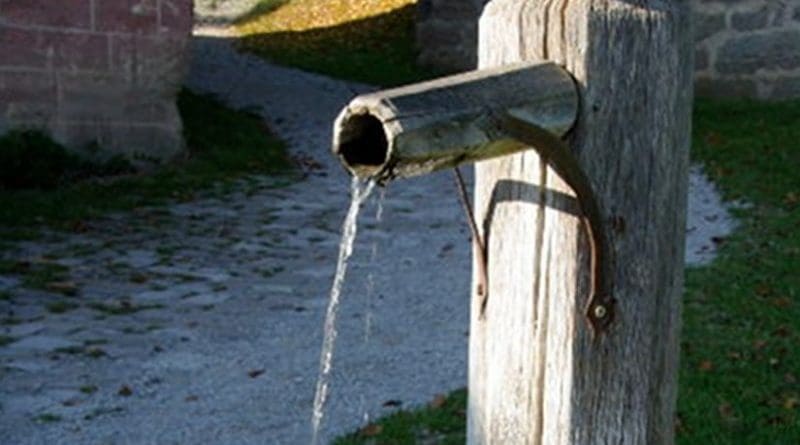Small Water Storage Not Mega-Dams Serve Poor Farmers Better – OpEd
A large part of the world is currently experiencing water shortages and the poor are the most affected adversely. These poor, especially the farmers, can be served better by small water storage, and not by mega-dams.
This is a gist of a technical paper Spreading the Water Wealth written by Patrick McCully, former executive director of the Berkeley (California)-based International Rivers (formerly known as International Rivers Network, or IRN), an advocacy group that supports communities around the world opposing destructive river development projects, and promotes sustainable and equitable freshwater management and energy policies.
“The ability to store water for when it is most needed, is certainly vital especially for farmers in those regions of the world where rainfall varies widely over each year and between years. And global warming is making the ability to store water even more important.”
“Large reservoirs are not the only form of water storage. Water stored in small reservoirs, in groundwater and in wetlands generally provides much greater economic benefits—and benefits that are more likelytoreach the poorest—than that in large reservoirs, “he said.
Small reservoirs and rainwater harvesting structures, such as the 300,000 liters agricultural tanks in South India and the million liter ponds in China are more likely to benefit farmers as they are geographically dispersed and more likely to be built and controlled at the community level.
“Large reservoirs, in contrast, mainly provide benefits to the relatively wealthy minority of large farmers living in the fertile plain areas that usually receive canal water. In many respects, the best way in storing water is underground. Groundwater does not evaporate, is well protected from biological contamination, is geographically dispersed and provided energy or pumping, can be accessed whenever needed, “McCully said.
The fact that farmers, rather than irrigation agencies control when groundwater is supplied to crops is the main reason why crop yields in areas irrigated by groundwater, are often double than those in fields irrigated by canal watered schemes.
In Pune, India where I led agroforestry projects, groundwater has recently overtaken rivers as the main supplier mof water for crops. The same is true in the Iringa region of Tanzania where 60, percent of the country’s irrigated area is sustained.
According to Adin Dob Roy and Tushaar Shaab of the International Water Institute: IWI, “groundwater is the democratic water source and poverty reduction tool in India.”
Yet, many governments currently focus most of their budgetary resources and manpower on centrally created and managed large canal irrigated systems from mega-dams allowing only a fraction of groundwater resources.
The downside of groundwater use is that in many areas, it is being used much faster than it is replenished via rainfall and floods. In areas where groundwater is abused, it can lead to collapse of agriculture and contamination of drinking water supply with saline water.
From the perspective of food production and poverty alleviation,, it is far more important to implement policies to manage groundwater extraction and practices to recharge aquifers than to invest in more big dam projects.
The Dangers of Hydro-Addiction
McCully wrote, “the argument much-used by the hydro power industry, that developed countries could escape poverty, if only they could use more of their hydro-potential, is beset by over- simplification and irrelevance as the per capita myth.
While there is a clear trend for countries to get rich as they increase their use of modern energy, the trend goes the other way for hydroelectricity dependency.
Hydropower provides 50 percent of electricity in 58 countries in the world and more than 90 percent in 24 countries. The majority of these hydro-dependent countries are among those with lowest human indicators as measured by the UN Development Program.
Of the world’s 40 richest countries measured by per capita GNP, only one is more than 90 percent hydro-dependent. Of the world’s 40 poorest countries, 15 are more than 90 percent hydro dependent.
Numerous hydro-dependent countries have suffered drought-induced blackouts and energy rationing in recent years. Mega-dam construction displaces people destroys biodiversity, culture and indigenous knowledge.
While developing countries have much more unexploited hydro power potential than developed countries, they also have massive unexploited potential for new renewable technologies such as wind, solar, geothermal and modern biomass energy.”
The Poor Must be a Priority
Just as the great majority of people without access to water live in rural areas of developing countries, so do most of the 1.6 billion without access to electricity. The energy needs of poor rural areas are most likely to be met by improved cook stoves, mini and micro hydro projects, and other small renewable energy sources such as wind–powered pumps for lifting groundwater. Massive hydropower projects that power transmission lines headed to mines, industries and big cities rarely provide benefits to rural people.
Improving access to water and energy in rural communities across the developing world would free women and children from the drudgery of many hours spent every day carrying water and gathering fuelwood. It would dramatically improve people’s health (especially if coupled with low–cost sanitation schemes). And it would reduce hunger and increase incomes, not just because of greater yields, but also because of the greater availability of energy for crop processing. Furthermore small–scale technologies are just as viable for meeting the water and energy needs of the sprawling slums of the developing world.
Intelligent water and energy infrastructure development alone cannot solve the scandal of global poverty and inequality. Many other policy and institutional changes are also needed. But without a radical realignment of priorities in the water and energy sectors, the hope of water and energy for all will remain a distant dream.

